Inclusive Practice: Factors Impacting Learning, Policy Frameworks
VerifiedAdded on 2023/06/13
|14
|4462
|314
Report
AI Summary
This report provides a comprehensive overview of inclusive practice, beginning with an introduction to learning and inclusive practice, followed by an examination of factors impacting learning, including personal, social, cultural, cognitive, physical, and sensory abilities. It delves into the policy and regulatory frameworks related to inclusive practice, such as the Disability Discrimination Act, Child Protection guidelines, and the Equality Act, and how these frameworks influence organizational policies and individual practice. The report also outlines the roles and responsibilities of professionals in inclusive practice, emphasizing the importance of identifying children with special disabilities, developing new teaching strategies, and fostering collaboration among professionals. Furthermore, it reviews the key features and benefits of an inclusive learning environment, analyzes ways to promote equality, diversity, and inclusion, and discusses strategies for effective liaison between professionals. Finally, the report includes a review of the effectiveness of one's own inclusive practice, identifying strengths and areas for improvement, and planning opportunities to enhance skills in inclusive practice.
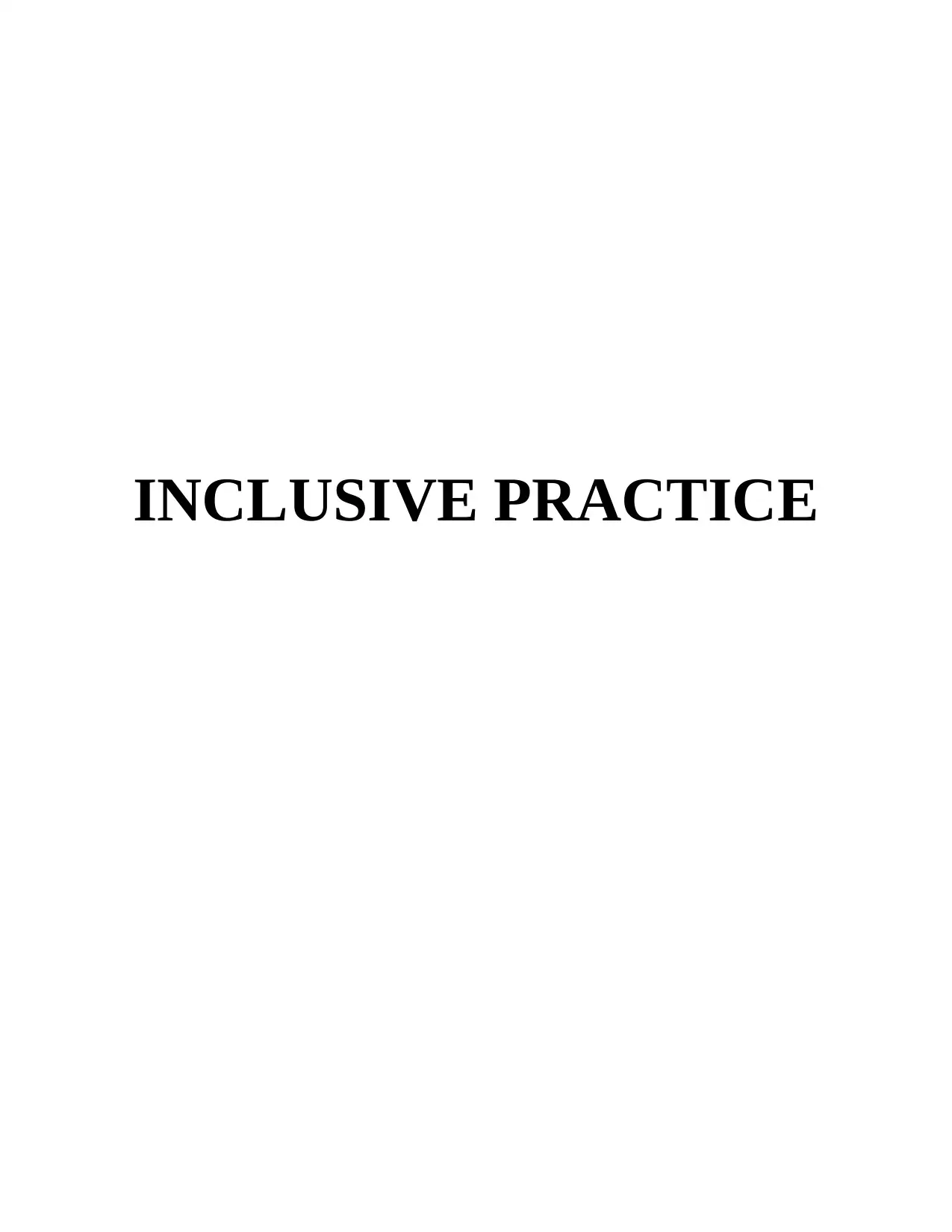
INCLUSIVE PRACTICE
Paraphrase This Document
Need a fresh take? Get an instant paraphrase of this document with our AI Paraphraser
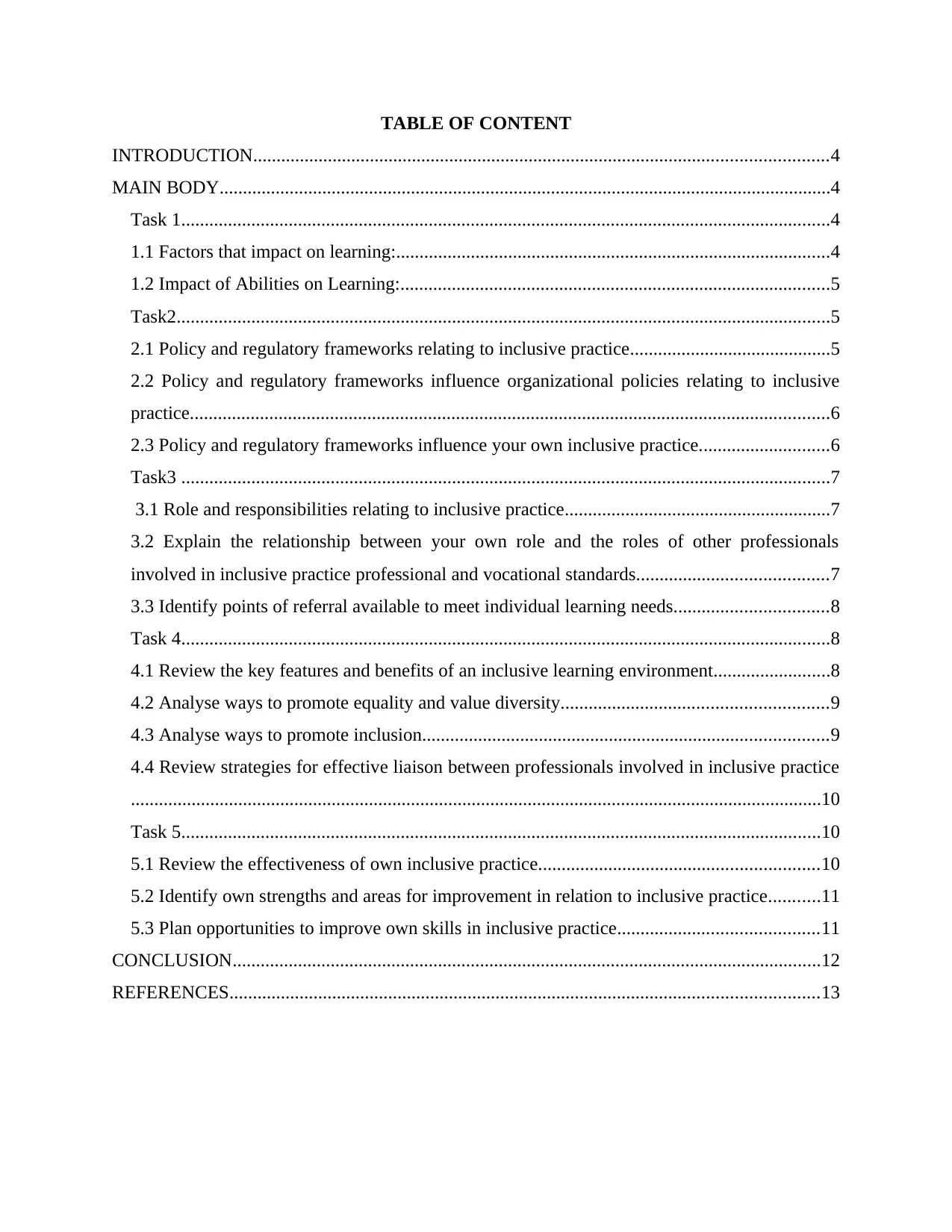
TABLE OF CONTENT
INTRODUCTION...........................................................................................................................4
MAIN BODY...................................................................................................................................4
Task 1...........................................................................................................................................4
1.1 Factors that impact on learning:.............................................................................................4
1.2 Impact of Abilities on Learning:............................................................................................5
Task2............................................................................................................................................5
2.1 Policy and regulatory frameworks relating to inclusive practice...........................................5
2.2 Policy and regulatory frameworks influence organizational policies relating to inclusive
practice.........................................................................................................................................6
2.3 Policy and regulatory frameworks influence your own inclusive practice............................6
Task3 ...........................................................................................................................................7
3.1 Role and responsibilities relating to inclusive practice.........................................................7
3.2 Explain the relationship between your own role and the roles of other professionals
involved in inclusive practice professional and vocational standards.........................................7
3.3 Identify points of referral available to meet individual learning needs.................................8
Task 4...........................................................................................................................................8
4.1 Review the key features and benefits of an inclusive learning environment.........................8
4.2 Analyse ways to promote equality and value diversity.........................................................9
4.3 Analyse ways to promote inclusion.......................................................................................9
4.4 Review strategies for effective liaison between professionals involved in inclusive practice
....................................................................................................................................................10
Task 5.........................................................................................................................................10
5.1 Review the effectiveness of own inclusive practice............................................................10
5.2 Identify own strengths and areas for improvement in relation to inclusive practice...........11
5.3 Plan opportunities to improve own skills in inclusive practice...........................................11
CONCLUSION..............................................................................................................................12
REFERENCES..............................................................................................................................13
INTRODUCTION...........................................................................................................................4
MAIN BODY...................................................................................................................................4
Task 1...........................................................................................................................................4
1.1 Factors that impact on learning:.............................................................................................4
1.2 Impact of Abilities on Learning:............................................................................................5
Task2............................................................................................................................................5
2.1 Policy and regulatory frameworks relating to inclusive practice...........................................5
2.2 Policy and regulatory frameworks influence organizational policies relating to inclusive
practice.........................................................................................................................................6
2.3 Policy and regulatory frameworks influence your own inclusive practice............................6
Task3 ...........................................................................................................................................7
3.1 Role and responsibilities relating to inclusive practice.........................................................7
3.2 Explain the relationship between your own role and the roles of other professionals
involved in inclusive practice professional and vocational standards.........................................7
3.3 Identify points of referral available to meet individual learning needs.................................8
Task 4...........................................................................................................................................8
4.1 Review the key features and benefits of an inclusive learning environment.........................8
4.2 Analyse ways to promote equality and value diversity.........................................................9
4.3 Analyse ways to promote inclusion.......................................................................................9
4.4 Review strategies for effective liaison between professionals involved in inclusive practice
....................................................................................................................................................10
Task 5.........................................................................................................................................10
5.1 Review the effectiveness of own inclusive practice............................................................10
5.2 Identify own strengths and areas for improvement in relation to inclusive practice...........11
5.3 Plan opportunities to improve own skills in inclusive practice...........................................11
CONCLUSION..............................................................................................................................12
REFERENCES..............................................................................................................................13
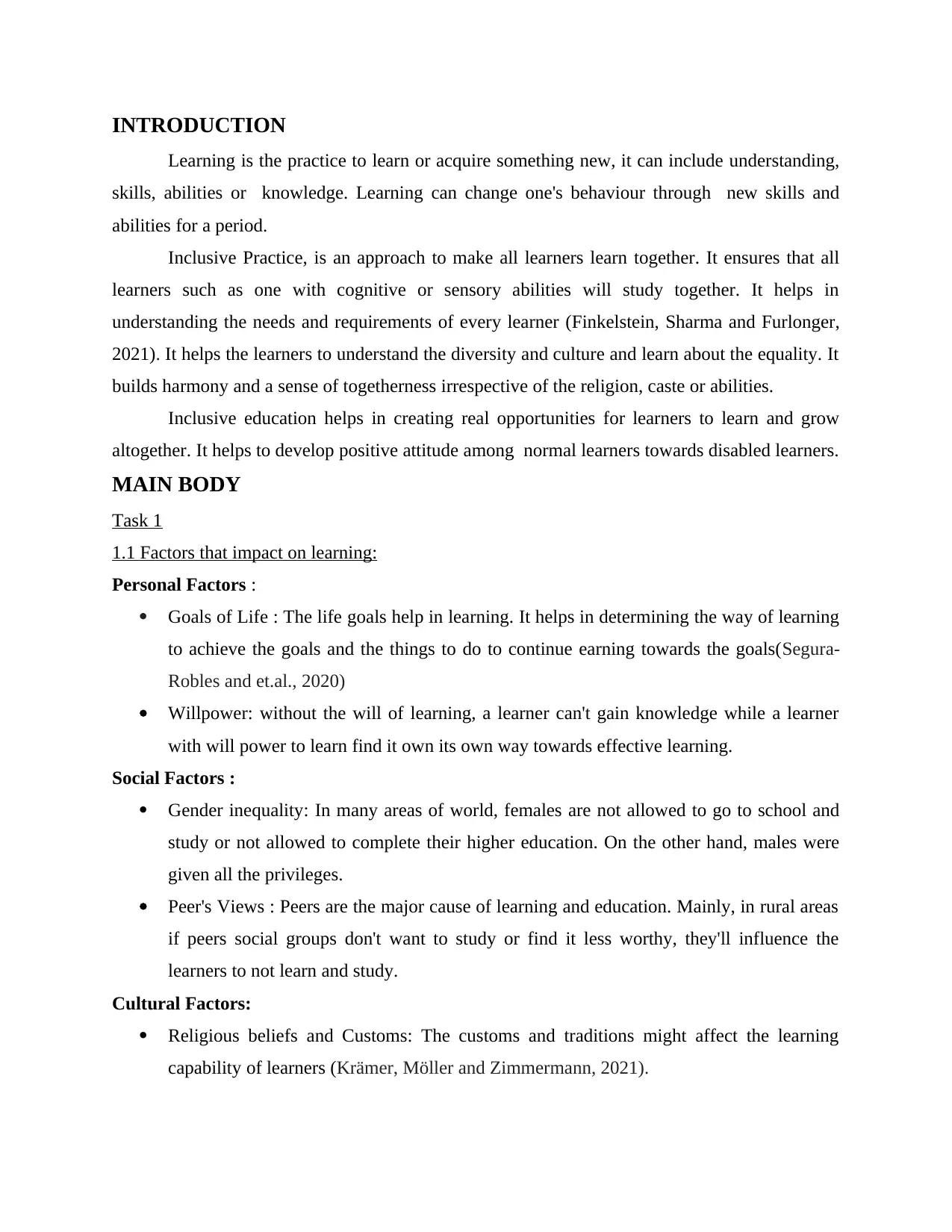
INTRODUCTION
Learning is the practice to learn or acquire something new, it can include understanding,
skills, abilities or knowledge. Learning can change one's behaviour through new skills and
abilities for a period.
Inclusive Practice, is an approach to make all learners learn together. It ensures that all
learners such as one with cognitive or sensory abilities will study together. It helps in
understanding the needs and requirements of every learner (Finkelstein, Sharma and Furlonger,
2021). It helps the learners to understand the diversity and culture and learn about the equality. It
builds harmony and a sense of togetherness irrespective of the religion, caste or abilities.
Inclusive education helps in creating real opportunities for learners to learn and grow
altogether. It helps to develop positive attitude among normal learners towards disabled learners.
MAIN BODY
Task 1
1.1 Factors that impact on learning:
Personal Factors :
Goals of Life : The life goals help in learning. It helps in determining the way of learning
to achieve the goals and the things to do to continue earning towards the goals(Segura-
Robles and et.al., 2020)
Willpower: without the will of learning, a learner can't gain knowledge while a learner
with will power to learn find it own its own way towards effective learning.
Social Factors :
Gender inequality: In many areas of world, females are not allowed to go to school and
study or not allowed to complete their higher education. On the other hand, males were
given all the privileges.
Peer's Views : Peers are the major cause of learning and education. Mainly, in rural areas
if peers social groups don't want to study or find it less worthy, they'll influence the
learners to not learn and study.
Cultural Factors:
Religious beliefs and Customs: The customs and traditions might affect the learning
capability of learners (Krämer, Möller and Zimmermann, 2021).
Learning is the practice to learn or acquire something new, it can include understanding,
skills, abilities or knowledge. Learning can change one's behaviour through new skills and
abilities for a period.
Inclusive Practice, is an approach to make all learners learn together. It ensures that all
learners such as one with cognitive or sensory abilities will study together. It helps in
understanding the needs and requirements of every learner (Finkelstein, Sharma and Furlonger,
2021). It helps the learners to understand the diversity and culture and learn about the equality. It
builds harmony and a sense of togetherness irrespective of the religion, caste or abilities.
Inclusive education helps in creating real opportunities for learners to learn and grow
altogether. It helps to develop positive attitude among normal learners towards disabled learners.
MAIN BODY
Task 1
1.1 Factors that impact on learning:
Personal Factors :
Goals of Life : The life goals help in learning. It helps in determining the way of learning
to achieve the goals and the things to do to continue earning towards the goals(Segura-
Robles and et.al., 2020)
Willpower: without the will of learning, a learner can't gain knowledge while a learner
with will power to learn find it own its own way towards effective learning.
Social Factors :
Gender inequality: In many areas of world, females are not allowed to go to school and
study or not allowed to complete their higher education. On the other hand, males were
given all the privileges.
Peer's Views : Peers are the major cause of learning and education. Mainly, in rural areas
if peers social groups don't want to study or find it less worthy, they'll influence the
learners to not learn and study.
Cultural Factors:
Religious beliefs and Customs: The customs and traditions might affect the learning
capability of learners (Krämer, Möller and Zimmermann, 2021).
⊘ This is a preview!⊘
Do you want full access?
Subscribe today to unlock all pages.

Trusted by 1+ million students worldwide
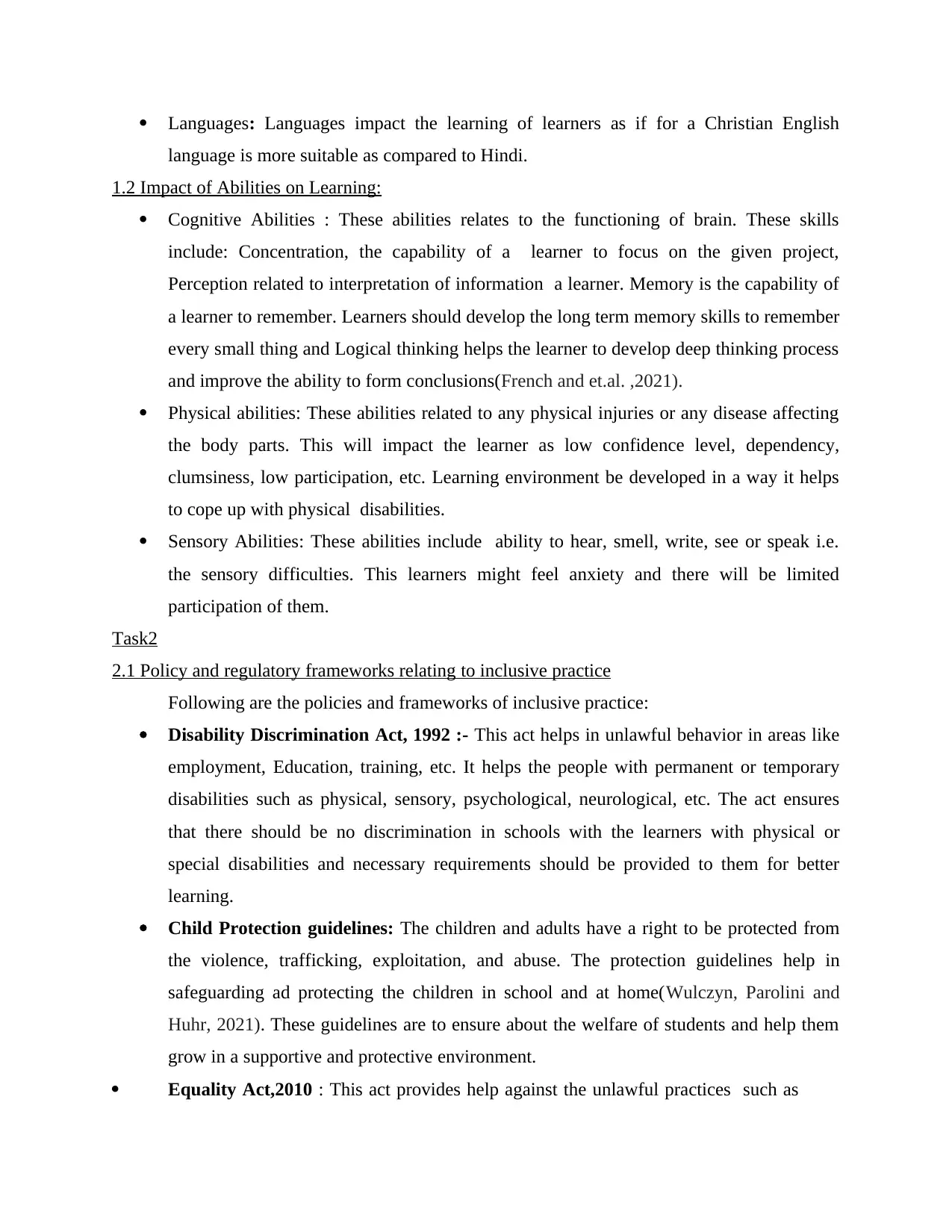
Languages: Languages impact the learning of learners as if for a Christian English
language is more suitable as compared to Hindi.
1.2 Impact of Abilities on Learning:
Cognitive Abilities : These abilities relates to the functioning of brain. These skills
include: Concentration, the capability of a learner to focus on the given project,
Perception related to interpretation of information a learner. Memory is the capability of
a learner to remember. Learners should develop the long term memory skills to remember
every small thing and Logical thinking helps the learner to develop deep thinking process
and improve the ability to form conclusions(French and et.al. ,2021).
Physical abilities: These abilities related to any physical injuries or any disease affecting
the body parts. This will impact the learner as low confidence level, dependency,
clumsiness, low participation, etc. Learning environment be developed in a way it helps
to cope up with physical disabilities.
Sensory Abilities: These abilities include ability to hear, smell, write, see or speak i.e.
the sensory difficulties. This learners might feel anxiety and there will be limited
participation of them.
Task2
2.1 Policy and regulatory frameworks relating to inclusive practice
Following are the policies and frameworks of inclusive practice:
Disability Discrimination Act, 1992 :- This act helps in unlawful behavior in areas like
employment, Education, training, etc. It helps the people with permanent or temporary
disabilities such as physical, sensory, psychological, neurological, etc. The act ensures
that there should be no discrimination in schools with the learners with physical or
special disabilities and necessary requirements should be provided to them for better
learning.
Child Protection guidelines: The children and adults have a right to be protected from
the violence, trafficking, exploitation, and abuse. The protection guidelines help in
safeguarding ad protecting the children in school and at home(Wulczyn, Parolini and
Huhr, 2021). These guidelines are to ensure about the welfare of students and help them
grow in a supportive and protective environment.
Equality Act,2010 : This act provides help against the unlawful practices such as
language is more suitable as compared to Hindi.
1.2 Impact of Abilities on Learning:
Cognitive Abilities : These abilities relates to the functioning of brain. These skills
include: Concentration, the capability of a learner to focus on the given project,
Perception related to interpretation of information a learner. Memory is the capability of
a learner to remember. Learners should develop the long term memory skills to remember
every small thing and Logical thinking helps the learner to develop deep thinking process
and improve the ability to form conclusions(French and et.al. ,2021).
Physical abilities: These abilities related to any physical injuries or any disease affecting
the body parts. This will impact the learner as low confidence level, dependency,
clumsiness, low participation, etc. Learning environment be developed in a way it helps
to cope up with physical disabilities.
Sensory Abilities: These abilities include ability to hear, smell, write, see or speak i.e.
the sensory difficulties. This learners might feel anxiety and there will be limited
participation of them.
Task2
2.1 Policy and regulatory frameworks relating to inclusive practice
Following are the policies and frameworks of inclusive practice:
Disability Discrimination Act, 1992 :- This act helps in unlawful behavior in areas like
employment, Education, training, etc. It helps the people with permanent or temporary
disabilities such as physical, sensory, psychological, neurological, etc. The act ensures
that there should be no discrimination in schools with the learners with physical or
special disabilities and necessary requirements should be provided to them for better
learning.
Child Protection guidelines: The children and adults have a right to be protected from
the violence, trafficking, exploitation, and abuse. The protection guidelines help in
safeguarding ad protecting the children in school and at home(Wulczyn, Parolini and
Huhr, 2021). These guidelines are to ensure about the welfare of students and help them
grow in a supportive and protective environment.
Equality Act,2010 : This act provides help against the unlawful practices such as
Paraphrase This Document
Need a fresh take? Get an instant paraphrase of this document with our AI Paraphraser
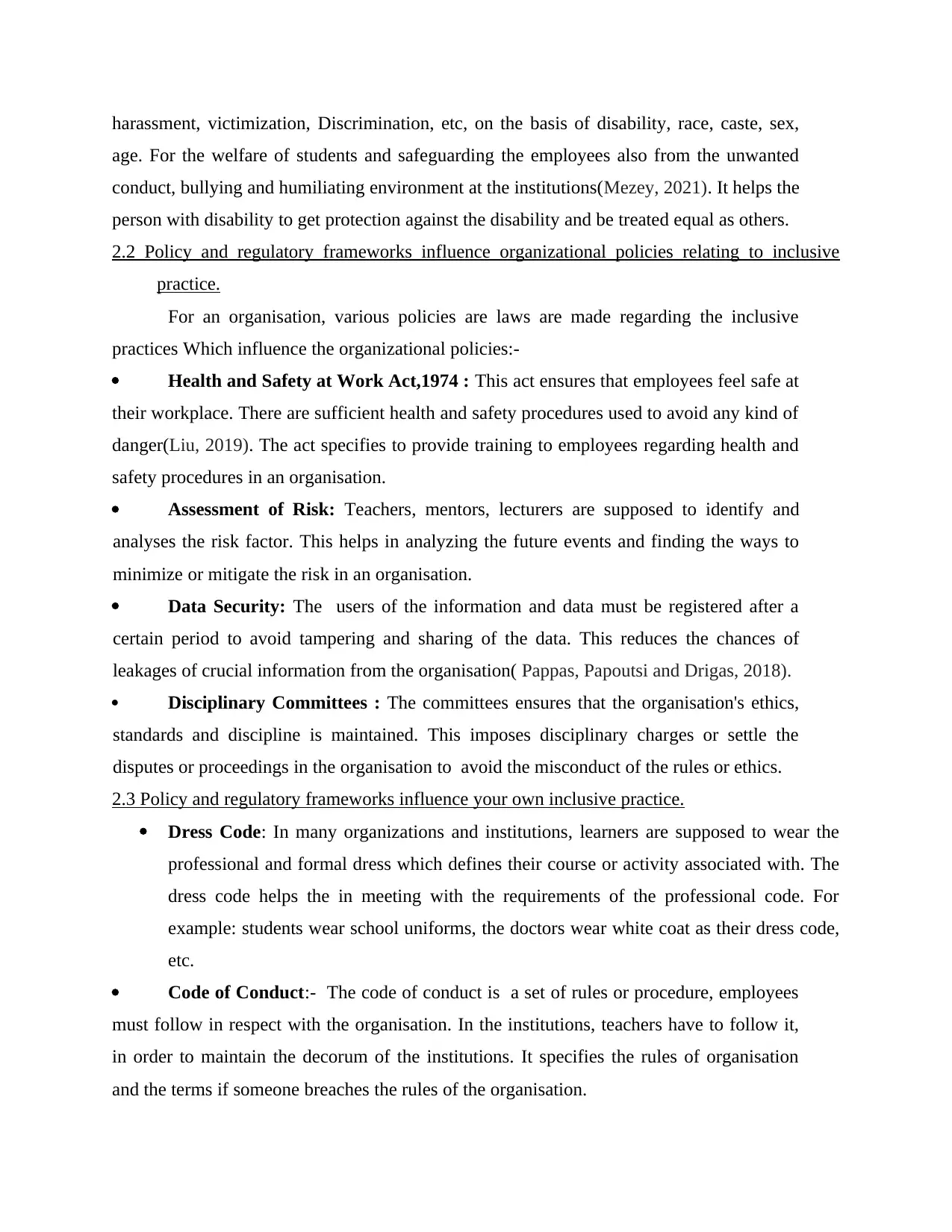
harassment, victimization, Discrimination, etc, on the basis of disability, race, caste, sex,
age. For the welfare of students and safeguarding the employees also from the unwanted
conduct, bullying and humiliating environment at the institutions(Mezey, 2021). It helps the
person with disability to get protection against the disability and be treated equal as others.
2.2 Policy and regulatory frameworks influence organizational policies relating to inclusive
practice.
For an organisation, various policies are laws are made regarding the inclusive
practices Which influence the organizational policies:-
Health and Safety at Work Act,1974 : This act ensures that employees feel safe at
their workplace. There are sufficient health and safety procedures used to avoid any kind of
danger(Liu, 2019). The act specifies to provide training to employees regarding health and
safety procedures in an organisation.
Assessment of Risk: Teachers, mentors, lecturers are supposed to identify and
analyses the risk factor. This helps in analyzing the future events and finding the ways to
minimize or mitigate the risk in an organisation.
Data Security: The users of the information and data must be registered after a
certain period to avoid tampering and sharing of the data. This reduces the chances of
leakages of crucial information from the organisation( Pappas, Papoutsi and Drigas, 2018).
Disciplinary Committees : The committees ensures that the organisation's ethics,
standards and discipline is maintained. This imposes disciplinary charges or settle the
disputes or proceedings in the organisation to avoid the misconduct of the rules or ethics.
2.3 Policy and regulatory frameworks influence your own inclusive practice.
Dress Code: In many organizations and institutions, learners are supposed to wear the
professional and formal dress which defines their course or activity associated with. The
dress code helps the in meeting with the requirements of the professional code. For
example: students wear school uniforms, the doctors wear white coat as their dress code,
etc.
Code of Conduct:- The code of conduct is a set of rules or procedure, employees
must follow in respect with the organisation. In the institutions, teachers have to follow it,
in order to maintain the decorum of the institutions. It specifies the rules of organisation
and the terms if someone breaches the rules of the organisation.
age. For the welfare of students and safeguarding the employees also from the unwanted
conduct, bullying and humiliating environment at the institutions(Mezey, 2021). It helps the
person with disability to get protection against the disability and be treated equal as others.
2.2 Policy and regulatory frameworks influence organizational policies relating to inclusive
practice.
For an organisation, various policies are laws are made regarding the inclusive
practices Which influence the organizational policies:-
Health and Safety at Work Act,1974 : This act ensures that employees feel safe at
their workplace. There are sufficient health and safety procedures used to avoid any kind of
danger(Liu, 2019). The act specifies to provide training to employees regarding health and
safety procedures in an organisation.
Assessment of Risk: Teachers, mentors, lecturers are supposed to identify and
analyses the risk factor. This helps in analyzing the future events and finding the ways to
minimize or mitigate the risk in an organisation.
Data Security: The users of the information and data must be registered after a
certain period to avoid tampering and sharing of the data. This reduces the chances of
leakages of crucial information from the organisation( Pappas, Papoutsi and Drigas, 2018).
Disciplinary Committees : The committees ensures that the organisation's ethics,
standards and discipline is maintained. This imposes disciplinary charges or settle the
disputes or proceedings in the organisation to avoid the misconduct of the rules or ethics.
2.3 Policy and regulatory frameworks influence your own inclusive practice.
Dress Code: In many organizations and institutions, learners are supposed to wear the
professional and formal dress which defines their course or activity associated with. The
dress code helps the in meeting with the requirements of the professional code. For
example: students wear school uniforms, the doctors wear white coat as their dress code,
etc.
Code of Conduct:- The code of conduct is a set of rules or procedure, employees
must follow in respect with the organisation. In the institutions, teachers have to follow it,
in order to maintain the decorum of the institutions. It specifies the rules of organisation
and the terms if someone breaches the rules of the organisation.
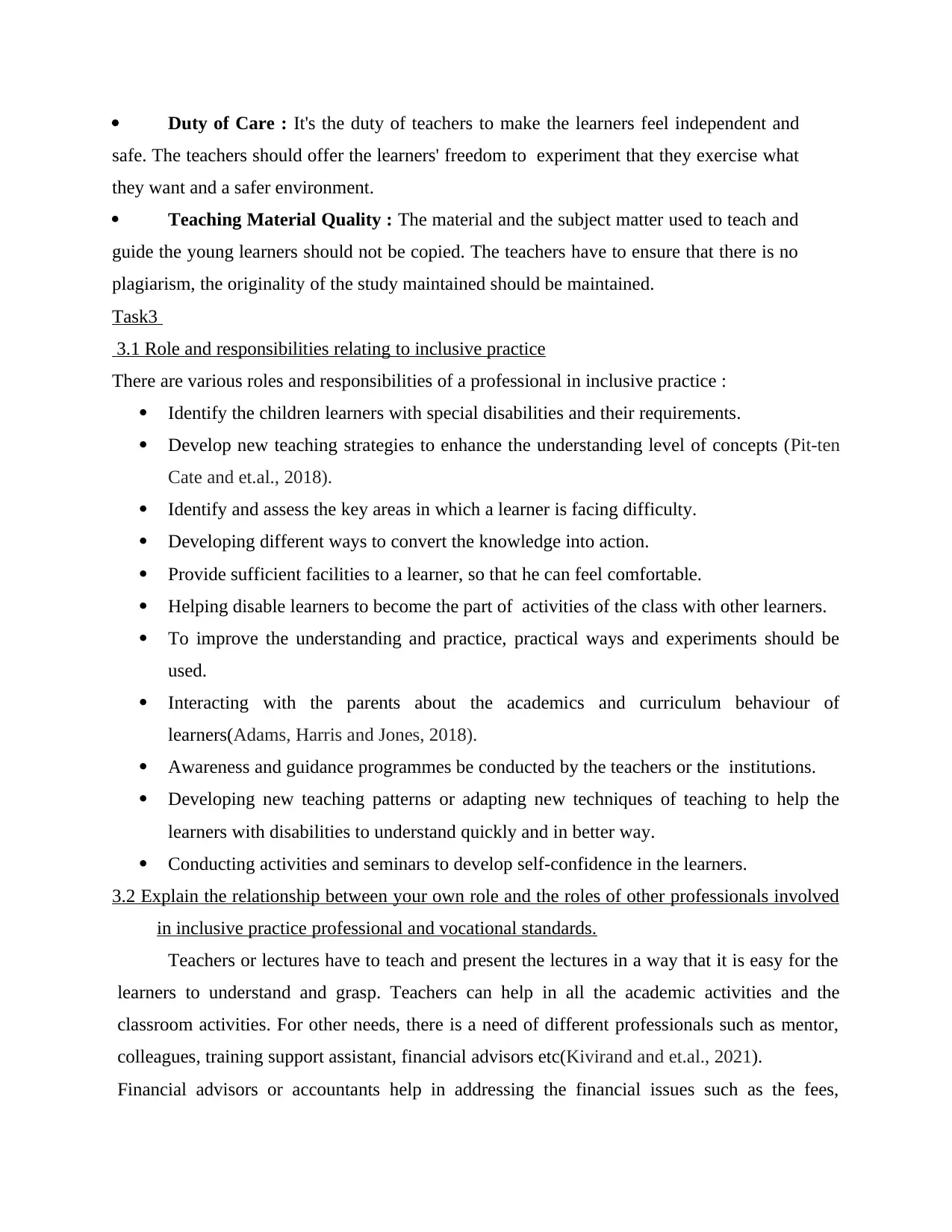
Duty of Care : It's the duty of teachers to make the learners feel independent and
safe. The teachers should offer the learners' freedom to experiment that they exercise what
they want and a safer environment.
Teaching Material Quality : The material and the subject matter used to teach and
guide the young learners should not be copied. The teachers have to ensure that there is no
plagiarism, the originality of the study maintained should be maintained.
Task3
3.1 Role and responsibilities relating to inclusive practice
There are various roles and responsibilities of a professional in inclusive practice :
Identify the children learners with special disabilities and their requirements.
Develop new teaching strategies to enhance the understanding level of concepts (Pit-ten
Cate and et.al., 2018).
Identify and assess the key areas in which a learner is facing difficulty.
Developing different ways to convert the knowledge into action.
Provide sufficient facilities to a learner, so that he can feel comfortable.
Helping disable learners to become the part of activities of the class with other learners.
To improve the understanding and practice, practical ways and experiments should be
used.
Interacting with the parents about the academics and curriculum behaviour of
learners(Adams, Harris and Jones, 2018).
Awareness and guidance programmes be conducted by the teachers or the institutions.
Developing new teaching patterns or adapting new techniques of teaching to help the
learners with disabilities to understand quickly and in better way.
Conducting activities and seminars to develop self-confidence in the learners.
3.2 Explain the relationship between your own role and the roles of other professionals involved
in inclusive practice professional and vocational standards.
Teachers or lectures have to teach and present the lectures in a way that it is easy for the
learners to understand and grasp. Teachers can help in all the academic activities and the
classroom activities. For other needs, there is a need of different professionals such as mentor,
colleagues, training support assistant, financial advisors etc(Kivirand and et.al., 2021).
Financial advisors or accountants help in addressing the financial issues such as the fees,
safe. The teachers should offer the learners' freedom to experiment that they exercise what
they want and a safer environment.
Teaching Material Quality : The material and the subject matter used to teach and
guide the young learners should not be copied. The teachers have to ensure that there is no
plagiarism, the originality of the study maintained should be maintained.
Task3
3.1 Role and responsibilities relating to inclusive practice
There are various roles and responsibilities of a professional in inclusive practice :
Identify the children learners with special disabilities and their requirements.
Develop new teaching strategies to enhance the understanding level of concepts (Pit-ten
Cate and et.al., 2018).
Identify and assess the key areas in which a learner is facing difficulty.
Developing different ways to convert the knowledge into action.
Provide sufficient facilities to a learner, so that he can feel comfortable.
Helping disable learners to become the part of activities of the class with other learners.
To improve the understanding and practice, practical ways and experiments should be
used.
Interacting with the parents about the academics and curriculum behaviour of
learners(Adams, Harris and Jones, 2018).
Awareness and guidance programmes be conducted by the teachers or the institutions.
Developing new teaching patterns or adapting new techniques of teaching to help the
learners with disabilities to understand quickly and in better way.
Conducting activities and seminars to develop self-confidence in the learners.
3.2 Explain the relationship between your own role and the roles of other professionals involved
in inclusive practice professional and vocational standards.
Teachers or lectures have to teach and present the lectures in a way that it is easy for the
learners to understand and grasp. Teachers can help in all the academic activities and the
classroom activities. For other needs, there is a need of different professionals such as mentor,
colleagues, training support assistant, financial advisors etc(Kivirand and et.al., 2021).
Financial advisors or accountants help in addressing the financial issues such as the fees,
⊘ This is a preview!⊘
Do you want full access?
Subscribe today to unlock all pages.

Trusted by 1+ million students worldwide
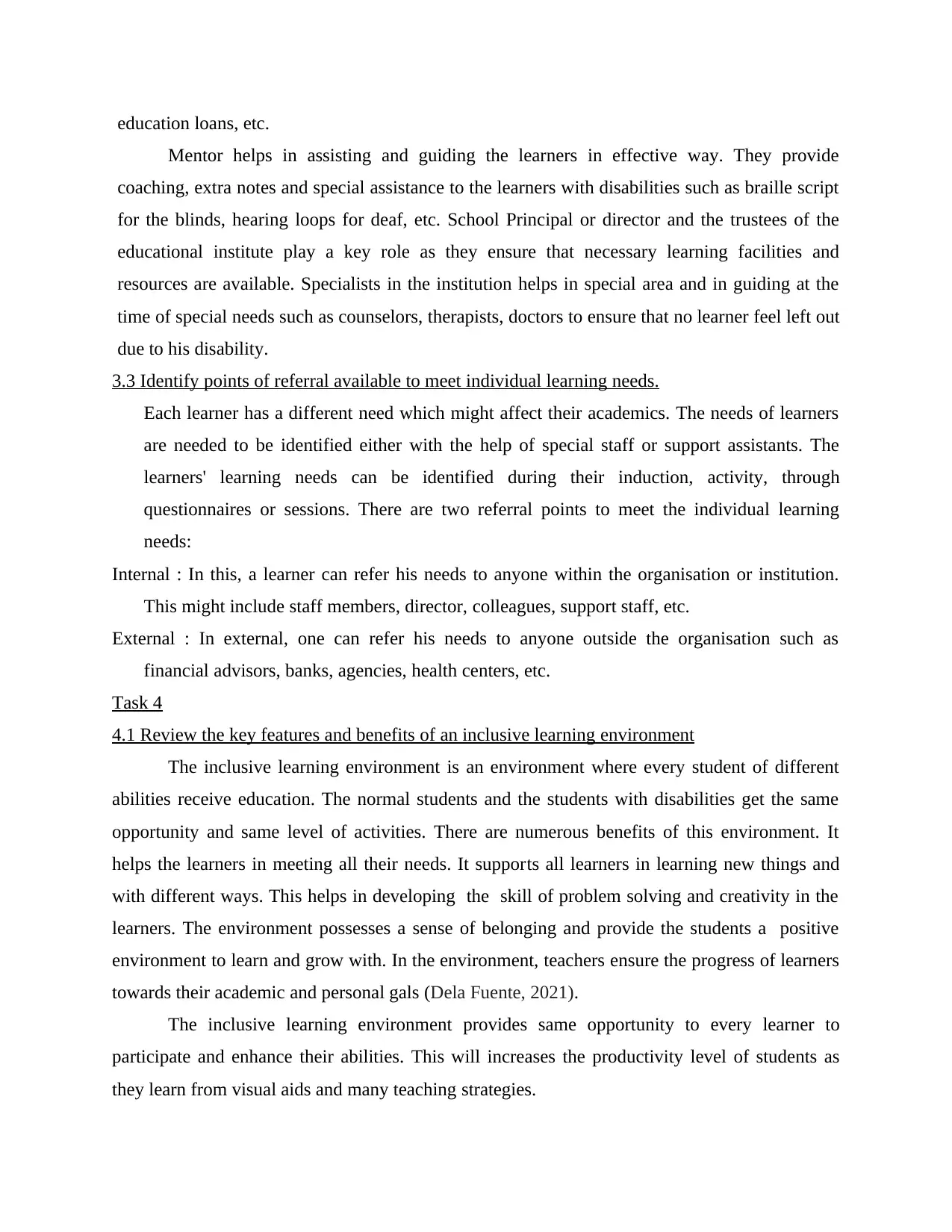
education loans, etc.
Mentor helps in assisting and guiding the learners in effective way. They provide
coaching, extra notes and special assistance to the learners with disabilities such as braille script
for the blinds, hearing loops for deaf, etc. School Principal or director and the trustees of the
educational institute play a key role as they ensure that necessary learning facilities and
resources are available. Specialists in the institution helps in special area and in guiding at the
time of special needs such as counselors, therapists, doctors to ensure that no learner feel left out
due to his disability.
3.3 Identify points of referral available to meet individual learning needs.
Each learner has a different need which might affect their academics. The needs of learners
are needed to be identified either with the help of special staff or support assistants. The
learners' learning needs can be identified during their induction, activity, through
questionnaires or sessions. There are two referral points to meet the individual learning
needs:
Internal : In this, a learner can refer his needs to anyone within the organisation or institution.
This might include staff members, director, colleagues, support staff, etc.
External : In external, one can refer his needs to anyone outside the organisation such as
financial advisors, banks, agencies, health centers, etc.
Task 4
4.1 Review the key features and benefits of an inclusive learning environment
The inclusive learning environment is an environment where every student of different
abilities receive education. The normal students and the students with disabilities get the same
opportunity and same level of activities. There are numerous benefits of this environment. It
helps the learners in meeting all their needs. It supports all learners in learning new things and
with different ways. This helps in developing the skill of problem solving and creativity in the
learners. The environment possesses a sense of belonging and provide the students a positive
environment to learn and grow with. In the environment, teachers ensure the progress of learners
towards their academic and personal gals (Dela Fuente, 2021).
The inclusive learning environment provides same opportunity to every learner to
participate and enhance their abilities. This will increases the productivity level of students as
they learn from visual aids and many teaching strategies.
Mentor helps in assisting and guiding the learners in effective way. They provide
coaching, extra notes and special assistance to the learners with disabilities such as braille script
for the blinds, hearing loops for deaf, etc. School Principal or director and the trustees of the
educational institute play a key role as they ensure that necessary learning facilities and
resources are available. Specialists in the institution helps in special area and in guiding at the
time of special needs such as counselors, therapists, doctors to ensure that no learner feel left out
due to his disability.
3.3 Identify points of referral available to meet individual learning needs.
Each learner has a different need which might affect their academics. The needs of learners
are needed to be identified either with the help of special staff or support assistants. The
learners' learning needs can be identified during their induction, activity, through
questionnaires or sessions. There are two referral points to meet the individual learning
needs:
Internal : In this, a learner can refer his needs to anyone within the organisation or institution.
This might include staff members, director, colleagues, support staff, etc.
External : In external, one can refer his needs to anyone outside the organisation such as
financial advisors, banks, agencies, health centers, etc.
Task 4
4.1 Review the key features and benefits of an inclusive learning environment
The inclusive learning environment is an environment where every student of different
abilities receive education. The normal students and the students with disabilities get the same
opportunity and same level of activities. There are numerous benefits of this environment. It
helps the learners in meeting all their needs. It supports all learners in learning new things and
with different ways. This helps in developing the skill of problem solving and creativity in the
learners. The environment possesses a sense of belonging and provide the students a positive
environment to learn and grow with. In the environment, teachers ensure the progress of learners
towards their academic and personal gals (Dela Fuente, 2021).
The inclusive learning environment provides same opportunity to every learner to
participate and enhance their abilities. This will increases the productivity level of students as
they learn from visual aids and many teaching strategies.
Paraphrase This Document
Need a fresh take? Get an instant paraphrase of this document with our AI Paraphraser
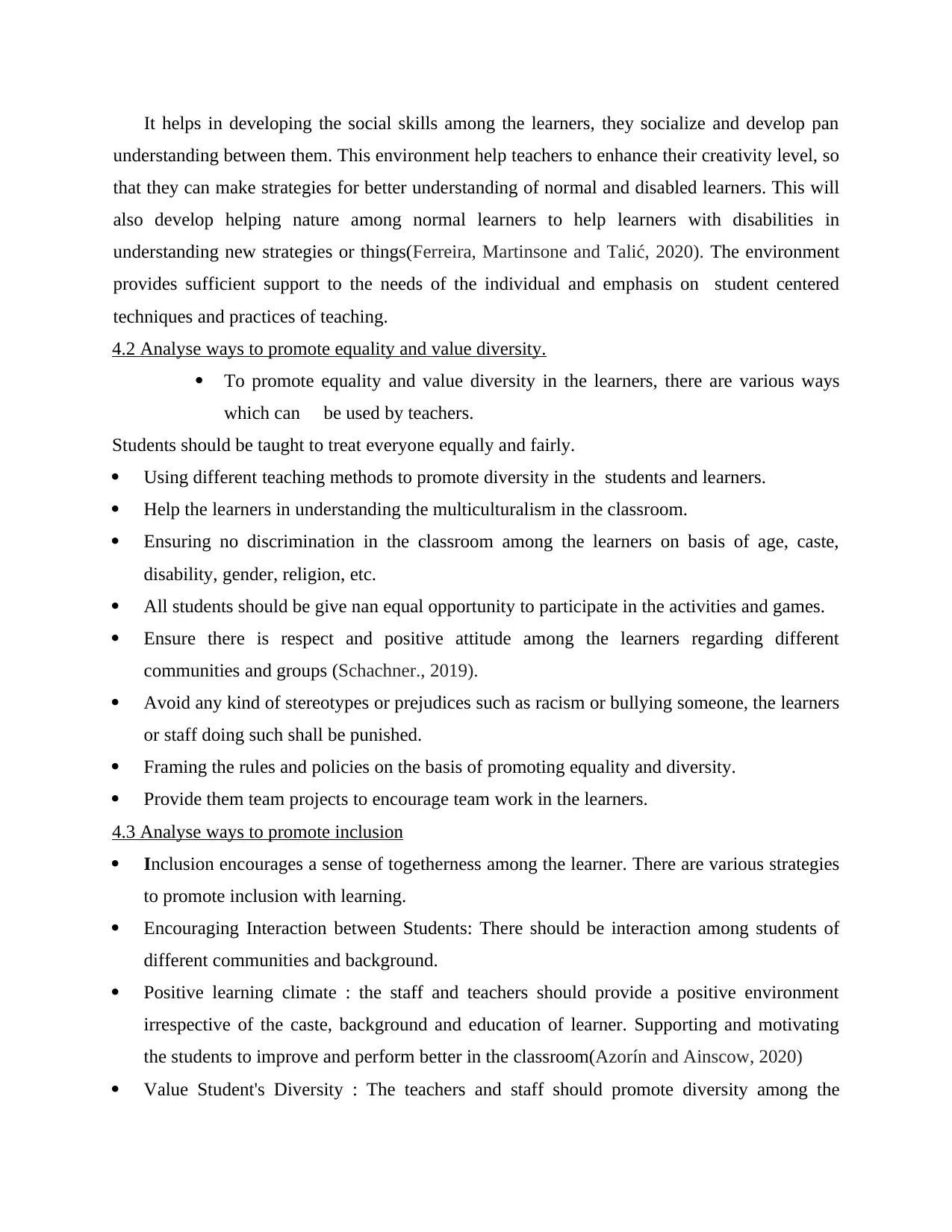
It helps in developing the social skills among the learners, they socialize and develop pan
understanding between them. This environment help teachers to enhance their creativity level, so
that they can make strategies for better understanding of normal and disabled learners. This will
also develop helping nature among normal learners to help learners with disabilities in
understanding new strategies or things(Ferreira, Martinsone and Talić, 2020). The environment
provides sufficient support to the needs of the individual and emphasis on student centered
techniques and practices of teaching.
4.2 Analyse ways to promote equality and value diversity.
To promote equality and value diversity in the learners, there are various ways
which can be used by teachers.
Students should be taught to treat everyone equally and fairly.
Using different teaching methods to promote diversity in the students and learners.
Help the learners in understanding the multiculturalism in the classroom.
Ensuring no discrimination in the classroom among the learners on basis of age, caste,
disability, gender, religion, etc.
All students should be give nan equal opportunity to participate in the activities and games.
Ensure there is respect and positive attitude among the learners regarding different
communities and groups (Schachner., 2019).
Avoid any kind of stereotypes or prejudices such as racism or bullying someone, the learners
or staff doing such shall be punished.
Framing the rules and policies on the basis of promoting equality and diversity.
Provide them team projects to encourage team work in the learners.
4.3 Analyse ways to promote inclusion
Inclusion encourages a sense of togetherness among the learner. There are various strategies
to promote inclusion with learning.
Encouraging Interaction between Students: There should be interaction among students of
different communities and background.
Positive learning climate : the staff and teachers should provide a positive environment
irrespective of the caste, background and education of learner. Supporting and motivating
the students to improve and perform better in the classroom(Azorín and Ainscow, 2020)
Value Student's Diversity : The teachers and staff should promote diversity among the
understanding between them. This environment help teachers to enhance their creativity level, so
that they can make strategies for better understanding of normal and disabled learners. This will
also develop helping nature among normal learners to help learners with disabilities in
understanding new strategies or things(Ferreira, Martinsone and Talić, 2020). The environment
provides sufficient support to the needs of the individual and emphasis on student centered
techniques and practices of teaching.
4.2 Analyse ways to promote equality and value diversity.
To promote equality and value diversity in the learners, there are various ways
which can be used by teachers.
Students should be taught to treat everyone equally and fairly.
Using different teaching methods to promote diversity in the students and learners.
Help the learners in understanding the multiculturalism in the classroom.
Ensuring no discrimination in the classroom among the learners on basis of age, caste,
disability, gender, religion, etc.
All students should be give nan equal opportunity to participate in the activities and games.
Ensure there is respect and positive attitude among the learners regarding different
communities and groups (Schachner., 2019).
Avoid any kind of stereotypes or prejudices such as racism or bullying someone, the learners
or staff doing such shall be punished.
Framing the rules and policies on the basis of promoting equality and diversity.
Provide them team projects to encourage team work in the learners.
4.3 Analyse ways to promote inclusion
Inclusion encourages a sense of togetherness among the learner. There are various strategies
to promote inclusion with learning.
Encouraging Interaction between Students: There should be interaction among students of
different communities and background.
Positive learning climate : the staff and teachers should provide a positive environment
irrespective of the caste, background and education of learner. Supporting and motivating
the students to improve and perform better in the classroom(Azorín and Ainscow, 2020)
Value Student's Diversity : The teachers and staff should promote diversity among the
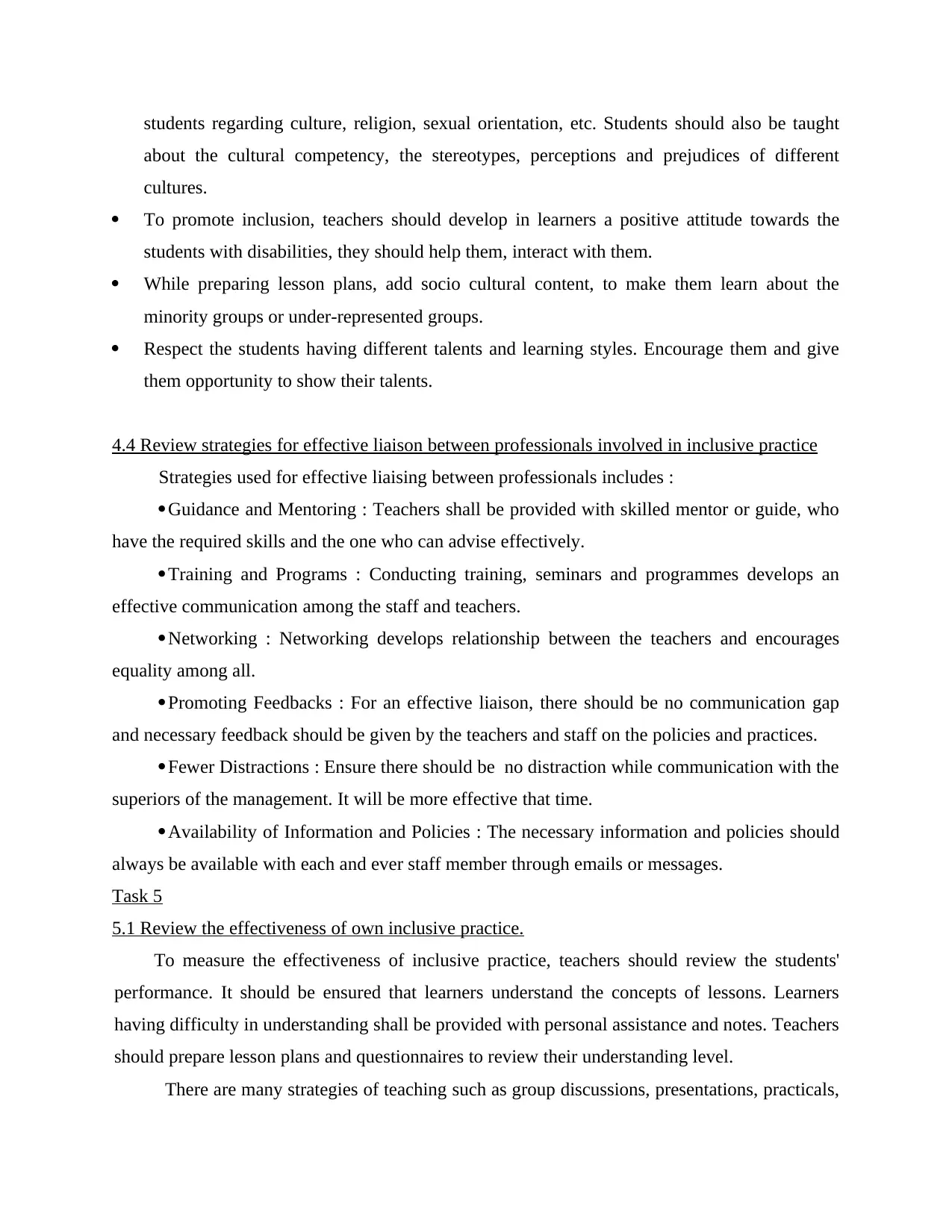
students regarding culture, religion, sexual orientation, etc. Students should also be taught
about the cultural competency, the stereotypes, perceptions and prejudices of different
cultures.
To promote inclusion, teachers should develop in learners a positive attitude towards the
students with disabilities, they should help them, interact with them.
While preparing lesson plans, add socio cultural content, to make them learn about the
minority groups or under-represented groups.
Respect the students having different talents and learning styles. Encourage them and give
them opportunity to show their talents.
4.4 Review strategies for effective liaison between professionals involved in inclusive practice
Strategies used for effective liaising between professionals includes :
Guidance and Mentoring : Teachers shall be provided with skilled mentor or guide, who
have the required skills and the one who can advise effectively.
Training and Programs : Conducting training, seminars and programmes develops an
effective communication among the staff and teachers.
Networking : Networking develops relationship between the teachers and encourages
equality among all.
Promoting Feedbacks : For an effective liaison, there should be no communication gap
and necessary feedback should be given by the teachers and staff on the policies and practices.
Fewer Distractions : Ensure there should be no distraction while communication with the
superiors of the management. It will be more effective that time.
Availability of Information and Policies : The necessary information and policies should
always be available with each and ever staff member through emails or messages.
Task 5
5.1 Review the effectiveness of own inclusive practice.
To measure the effectiveness of inclusive practice, teachers should review the students'
performance. It should be ensured that learners understand the concepts of lessons. Learners
having difficulty in understanding shall be provided with personal assistance and notes. Teachers
should prepare lesson plans and questionnaires to review their understanding level.
There are many strategies of teaching such as group discussions, presentations, practicals,
about the cultural competency, the stereotypes, perceptions and prejudices of different
cultures.
To promote inclusion, teachers should develop in learners a positive attitude towards the
students with disabilities, they should help them, interact with them.
While preparing lesson plans, add socio cultural content, to make them learn about the
minority groups or under-represented groups.
Respect the students having different talents and learning styles. Encourage them and give
them opportunity to show their talents.
4.4 Review strategies for effective liaison between professionals involved in inclusive practice
Strategies used for effective liaising between professionals includes :
Guidance and Mentoring : Teachers shall be provided with skilled mentor or guide, who
have the required skills and the one who can advise effectively.
Training and Programs : Conducting training, seminars and programmes develops an
effective communication among the staff and teachers.
Networking : Networking develops relationship between the teachers and encourages
equality among all.
Promoting Feedbacks : For an effective liaison, there should be no communication gap
and necessary feedback should be given by the teachers and staff on the policies and practices.
Fewer Distractions : Ensure there should be no distraction while communication with the
superiors of the management. It will be more effective that time.
Availability of Information and Policies : The necessary information and policies should
always be available with each and ever staff member through emails or messages.
Task 5
5.1 Review the effectiveness of own inclusive practice.
To measure the effectiveness of inclusive practice, teachers should review the students'
performance. It should be ensured that learners understand the concepts of lessons. Learners
having difficulty in understanding shall be provided with personal assistance and notes. Teachers
should prepare lesson plans and questionnaires to review their understanding level.
There are many strategies of teaching such as group discussions, presentations, practicals,
⊘ This is a preview!⊘
Do you want full access?
Subscribe today to unlock all pages.

Trusted by 1+ million students worldwide
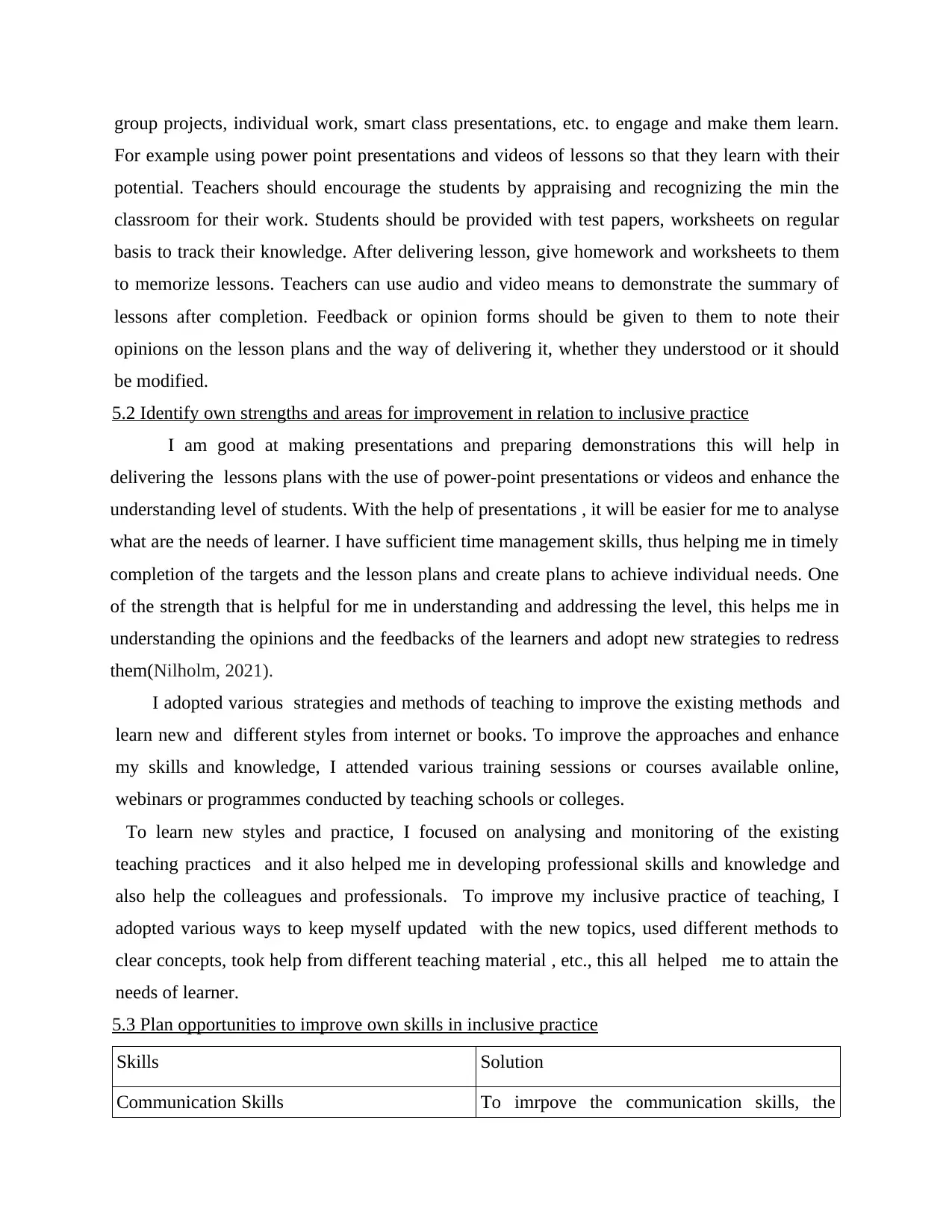
group projects, individual work, smart class presentations, etc. to engage and make them learn.
For example using power point presentations and videos of lessons so that they learn with their
potential. Teachers should encourage the students by appraising and recognizing the min the
classroom for their work. Students should be provided with test papers, worksheets on regular
basis to track their knowledge. After delivering lesson, give homework and worksheets to them
to memorize lessons. Teachers can use audio and video means to demonstrate the summary of
lessons after completion. Feedback or opinion forms should be given to them to note their
opinions on the lesson plans and the way of delivering it, whether they understood or it should
be modified.
5.2 Identify own strengths and areas for improvement in relation to inclusive practice
I am good at making presentations and preparing demonstrations this will help in
delivering the lessons plans with the use of power-point presentations or videos and enhance the
understanding level of students. With the help of presentations , it will be easier for me to analyse
what are the needs of learner. I have sufficient time management skills, thus helping me in timely
completion of the targets and the lesson plans and create plans to achieve individual needs. One
of the strength that is helpful for me in understanding and addressing the level, this helps me in
understanding the opinions and the feedbacks of the learners and adopt new strategies to redress
them(Nilholm, 2021).
I adopted various strategies and methods of teaching to improve the existing methods and
learn new and different styles from internet or books. To improve the approaches and enhance
my skills and knowledge, I attended various training sessions or courses available online,
webinars or programmes conducted by teaching schools or colleges.
To learn new styles and practice, I focused on analysing and monitoring of the existing
teaching practices and it also helped me in developing professional skills and knowledge and
also help the colleagues and professionals. To improve my inclusive practice of teaching, I
adopted various ways to keep myself updated with the new topics, used different methods to
clear concepts, took help from different teaching material , etc., this all helped me to attain the
needs of learner.
5.3 Plan opportunities to improve own skills in inclusive practice
Skills Solution
Communication Skills To imrpove the communication skills, the
For example using power point presentations and videos of lessons so that they learn with their
potential. Teachers should encourage the students by appraising and recognizing the min the
classroom for their work. Students should be provided with test papers, worksheets on regular
basis to track their knowledge. After delivering lesson, give homework and worksheets to them
to memorize lessons. Teachers can use audio and video means to demonstrate the summary of
lessons after completion. Feedback or opinion forms should be given to them to note their
opinions on the lesson plans and the way of delivering it, whether they understood or it should
be modified.
5.2 Identify own strengths and areas for improvement in relation to inclusive practice
I am good at making presentations and preparing demonstrations this will help in
delivering the lessons plans with the use of power-point presentations or videos and enhance the
understanding level of students. With the help of presentations , it will be easier for me to analyse
what are the needs of learner. I have sufficient time management skills, thus helping me in timely
completion of the targets and the lesson plans and create plans to achieve individual needs. One
of the strength that is helpful for me in understanding and addressing the level, this helps me in
understanding the opinions and the feedbacks of the learners and adopt new strategies to redress
them(Nilholm, 2021).
I adopted various strategies and methods of teaching to improve the existing methods and
learn new and different styles from internet or books. To improve the approaches and enhance
my skills and knowledge, I attended various training sessions or courses available online,
webinars or programmes conducted by teaching schools or colleges.
To learn new styles and practice, I focused on analysing and monitoring of the existing
teaching practices and it also helped me in developing professional skills and knowledge and
also help the colleagues and professionals. To improve my inclusive practice of teaching, I
adopted various ways to keep myself updated with the new topics, used different methods to
clear concepts, took help from different teaching material , etc., this all helped me to attain the
needs of learner.
5.3 Plan opportunities to improve own skills in inclusive practice
Skills Solution
Communication Skills To imrpove the communication skills, the
Paraphrase This Document
Need a fresh take? Get an instant paraphrase of this document with our AI Paraphraser
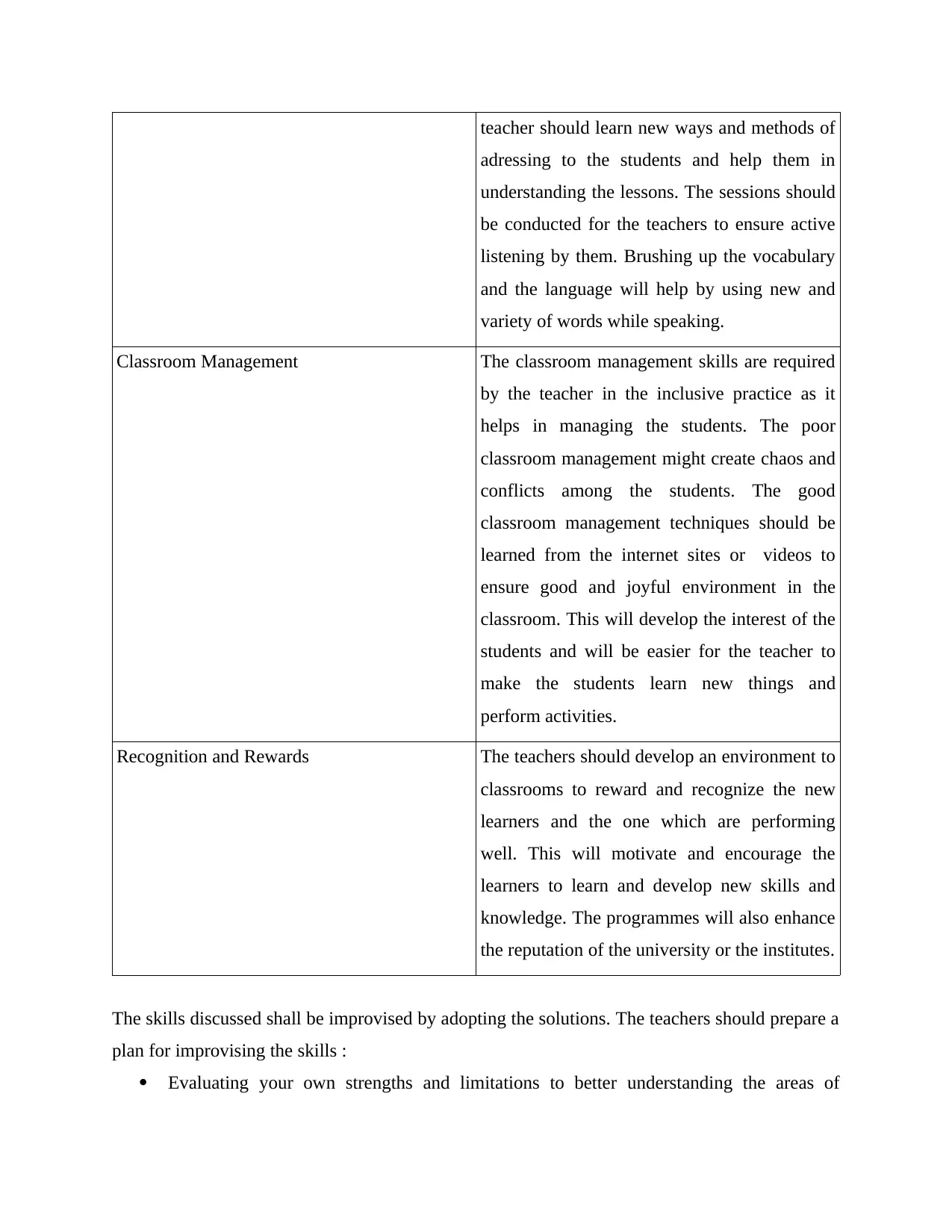
teacher should learn new ways and methods of
adressing to the students and help them in
understanding the lessons. The sessions should
be conducted for the teachers to ensure active
listening by them. Brushing up the vocabulary
and the language will help by using new and
variety of words while speaking.
Classroom Management The classroom management skills are required
by the teacher in the inclusive practice as it
helps in managing the students. The poor
classroom management might create chaos and
conflicts among the students. The good
classroom management techniques should be
learned from the internet sites or videos to
ensure good and joyful environment in the
classroom. This will develop the interest of the
students and will be easier for the teacher to
make the students learn new things and
perform activities.
Recognition and Rewards The teachers should develop an environment to
classrooms to reward and recognize the new
learners and the one which are performing
well. This will motivate and encourage the
learners to learn and develop new skills and
knowledge. The programmes will also enhance
the reputation of the university or the institutes.
The skills discussed shall be improvised by adopting the solutions. The teachers should prepare a
plan for improvising the skills :
Evaluating your own strengths and limitations to better understanding the areas of
adressing to the students and help them in
understanding the lessons. The sessions should
be conducted for the teachers to ensure active
listening by them. Brushing up the vocabulary
and the language will help by using new and
variety of words while speaking.
Classroom Management The classroom management skills are required
by the teacher in the inclusive practice as it
helps in managing the students. The poor
classroom management might create chaos and
conflicts among the students. The good
classroom management techniques should be
learned from the internet sites or videos to
ensure good and joyful environment in the
classroom. This will develop the interest of the
students and will be easier for the teacher to
make the students learn new things and
perform activities.
Recognition and Rewards The teachers should develop an environment to
classrooms to reward and recognize the new
learners and the one which are performing
well. This will motivate and encourage the
learners to learn and develop new skills and
knowledge. The programmes will also enhance
the reputation of the university or the institutes.
The skills discussed shall be improvised by adopting the solutions. The teachers should prepare a
plan for improvising the skills :
Evaluating your own strengths and limitations to better understanding the areas of
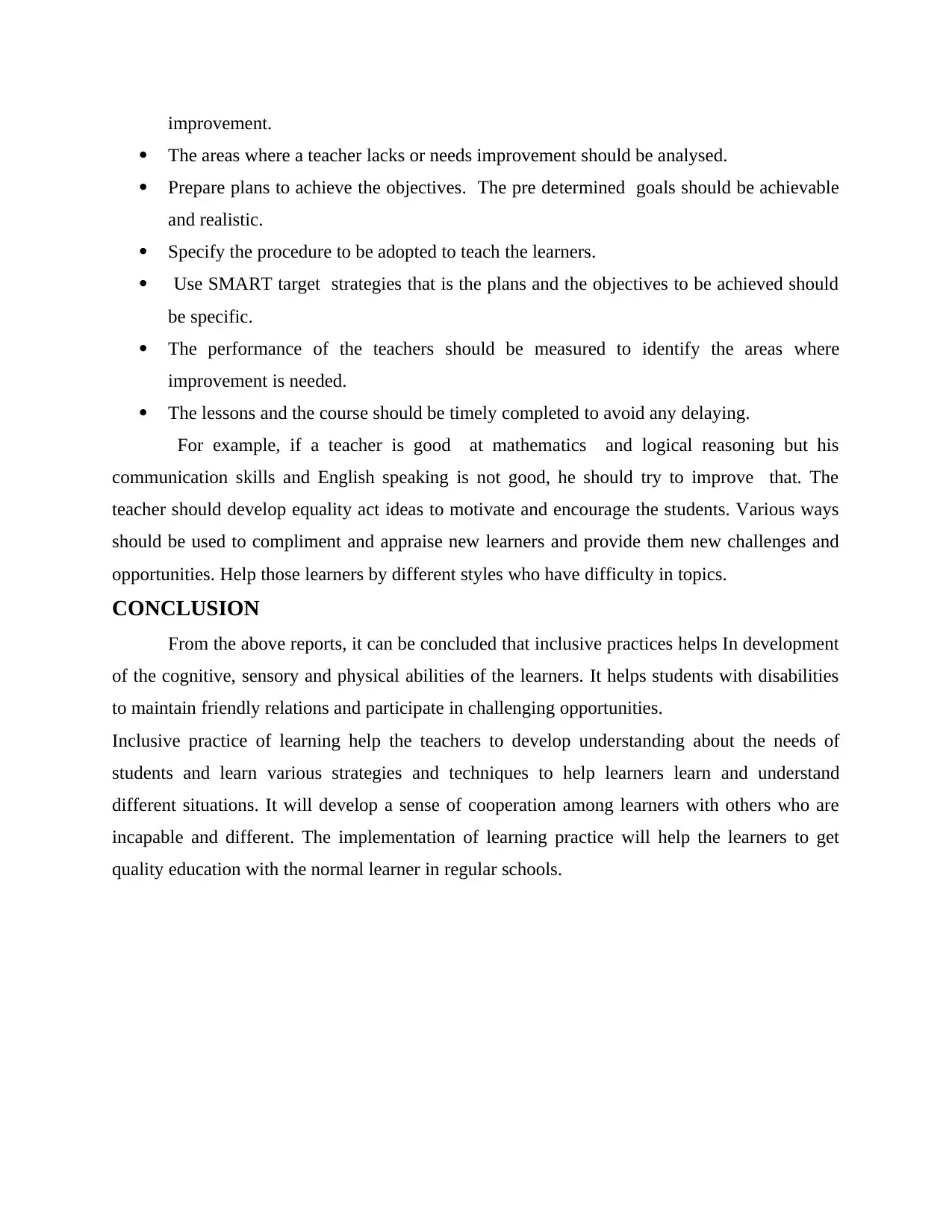
improvement.
The areas where a teacher lacks or needs improvement should be analysed.
Prepare plans to achieve the objectives. The pre determined goals should be achievable
and realistic.
Specify the procedure to be adopted to teach the learners.
Use SMART target strategies that is the plans and the objectives to be achieved should
be specific.
The performance of the teachers should be measured to identify the areas where
improvement is needed.
The lessons and the course should be timely completed to avoid any delaying.
For example, if a teacher is good at mathematics and logical reasoning but his
communication skills and English speaking is not good, he should try to improve that. The
teacher should develop equality act ideas to motivate and encourage the students. Various ways
should be used to compliment and appraise new learners and provide them new challenges and
opportunities. Help those learners by different styles who have difficulty in topics.
CONCLUSION
From the above reports, it can be concluded that inclusive practices helps In development
of the cognitive, sensory and physical abilities of the learners. It helps students with disabilities
to maintain friendly relations and participate in challenging opportunities.
Inclusive practice of learning help the teachers to develop understanding about the needs of
students and learn various strategies and techniques to help learners learn and understand
different situations. It will develop a sense of cooperation among learners with others who are
incapable and different. The implementation of learning practice will help the learners to get
quality education with the normal learner in regular schools.
The areas where a teacher lacks or needs improvement should be analysed.
Prepare plans to achieve the objectives. The pre determined goals should be achievable
and realistic.
Specify the procedure to be adopted to teach the learners.
Use SMART target strategies that is the plans and the objectives to be achieved should
be specific.
The performance of the teachers should be measured to identify the areas where
improvement is needed.
The lessons and the course should be timely completed to avoid any delaying.
For example, if a teacher is good at mathematics and logical reasoning but his
communication skills and English speaking is not good, he should try to improve that. The
teacher should develop equality act ideas to motivate and encourage the students. Various ways
should be used to compliment and appraise new learners and provide them new challenges and
opportunities. Help those learners by different styles who have difficulty in topics.
CONCLUSION
From the above reports, it can be concluded that inclusive practices helps In development
of the cognitive, sensory and physical abilities of the learners. It helps students with disabilities
to maintain friendly relations and participate in challenging opportunities.
Inclusive practice of learning help the teachers to develop understanding about the needs of
students and learn various strategies and techniques to help learners learn and understand
different situations. It will develop a sense of cooperation among learners with others who are
incapable and different. The implementation of learning practice will help the learners to get
quality education with the normal learner in regular schools.
⊘ This is a preview!⊘
Do you want full access?
Subscribe today to unlock all pages.

Trusted by 1+ million students worldwide
1 out of 14
Related Documents
Your All-in-One AI-Powered Toolkit for Academic Success.
+13062052269
info@desklib.com
Available 24*7 on WhatsApp / Email
![[object Object]](/_next/static/media/star-bottom.7253800d.svg)
Unlock your academic potential
Copyright © 2020–2025 A2Z Services. All Rights Reserved. Developed and managed by ZUCOL.




